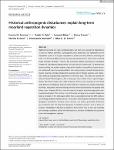Historical anthropogenic disturbances explain long-term moorland vegetation dynamics
| dc.contributor.author | Rowney, FM | |
| dc.contributor.author | Fyfe, R | |
| dc.contributor.author | Baker, L | |
| dc.contributor.author | French, H | |
| dc.contributor.author | Koot, M | |
| dc.contributor.author | Ombashi, H | |
| dc.contributor.author | Timms, R | |
| dc.date.accessioned | 2023-04-24T13:56:54Z | |
| dc.date.available | 2023-04-24T13:56:54Z | |
| dc.date.issued | 2023-03-08 | |
| dc.identifier.issn | 2045-7758 | |
| dc.identifier.issn | 2045-7758 | |
| dc.identifier.other | ARTN e9876 | |
| dc.identifier.uri | https://pearl.plymouth.ac.uk/handle/10026.1/20756 | |
| dc.description.abstract |
Upland moorlands are important landscapes, but many are considered degraded as a result of human activities. Consequently, their protection and restoration are of substantial concern. In Europe, restoration activities are often aimed at reversing the effects of 19th and 20th century “agricultural improvements,” which often involved major drainage schemes. However, the ecological effects and long-term ecological context of “agricultural improvement” are not yet fully understood. To develop this understanding, we analyze paleoecological data (pollen, coprophilous fungal spores, microcharcoal) from five upland peatland sites using a range of analytical approaches: cluster analysis, principal component analysis, rate-of-change analysis, and regression analyses incorporating documentary historical data. The sites are located on Exmoor (South West England, UK), a landscape that typifies historic upland degradation. We demonstrate that in this landscape, 19th century drainage is associated with declines in Sphagnum and non-arboreal taxon richness; over longer timescales burning is associated with enhanced graminoid monocot abundance and grazing with lower taxon richness. We also show that rate-of-change in moorland vegetation communities during the 19th century is not distinctive in a long-term context: change has been a constant in this landscape, rather than an exception during the 19th century. Our findings indicate that the aims of “restoration” interventions intended to increase Sphagnum abundances, increase taxon richness and reduce graminoid dominance are consistent with the long-term dynamics of peatland systems, such as those on Exmoor. “Restoration” deemed successful in these terms may or may not resemble pre-drainage conditions, which were themselves a function of millennia of successive moorland management regimes. | |
| dc.format.extent | e9876- | |
| dc.format.medium | Electronic-eCollection | |
| dc.language | en | |
| dc.publisher | Wiley Open Access | |
| dc.subject | coprophilous fungal spores | |
| dc.subject | interdisciplinary | |
| dc.subject | moorlands | |
| dc.subject | Paleoecology | |
| dc.subject | peatlands | |
| dc.subject | pollen | |
| dc.title | Historical anthropogenic disturbances explain long-term moorland vegetation dynamics | |
| dc.type | journal-article | |
| dc.type | Journal Article | |
| plymouth.author-url | https://www.webofscience.com/api/gateway?GWVersion=2&SrcApp=PARTNER_APP&SrcAuth=LinksAMR&KeyUT=WOS:000946090200001&DestLinkType=FullRecord&DestApp=ALL_WOS&UsrCustomerID=11bb513d99f797142bcfeffcc58ea008 | |
| plymouth.issue | 3 | |
| plymouth.volume | 13 | |
| plymouth.publication-status | Published | |
| plymouth.journal | Ecology and Evolution | |
| dc.identifier.doi | 10.1002/ece3.9876 | |
| plymouth.organisational-group | |Plymouth | |
| plymouth.organisational-group | |Plymouth|Research Groups | |
| plymouth.organisational-group | |Plymouth|Faculty of Science and Engineering | |
| plymouth.organisational-group | |Plymouth|Faculty of Science and Engineering|School of Geography, Earth and Environmental Sciences | |
| plymouth.organisational-group | |Plymouth|Research Groups|Marine Institute | |
| plymouth.organisational-group | |Plymouth|REF 2021 Researchers by UoA | |
| plymouth.organisational-group | |Plymouth|Users by role | |
| plymouth.organisational-group | |Plymouth|Users by role|Academics | |
| plymouth.organisational-group | |Plymouth|REF 2021 Researchers by UoA|UoA14 Geography and Environmental Studies | |
| plymouth.organisational-group | |Plymouth|Admin Group - REF | |
| plymouth.organisational-group | |Plymouth|Admin Group - REF|REF Admin Group - FoSE | |
| dc.publisher.place | England | |
| dcterms.dateAccepted | 2023-02-16 | |
| dc.date.updated | 2023-04-24T13:56:41Z | |
| dc.rights.embargodate | 2023-4-25 | |
| dc.identifier.eissn | 2045-7758 | |
| dc.rights.embargoperiod | forever | |
| rioxxterms.versionofrecord | 10.1002/ece3.9876 |


